DriveSure
Car Dealership Marketing: Metrics to Track (with Benchmarks)
You already know that marketing is a key component to selling and servicing more vehicles. But do you know just how well your marketing works for your dealership?
To get a clear answer to that question, you’ll need to know what to measure and how your metrics stack up. Only then can you really identify what’s performing well and what may need some adjustments.
Metrics to Measure
The specific metrics you use to gain insight into your marketing performance will depend on the strategy or strategies you’ve selected – if you aren’t running a social media campaign, social engagement metrics probably won’t offer you much.
With that in mind, we’ve gathered the top 8 metrics you should be measuring (as well as some benchmarks). So the next time someone asks, you’ll be able to say for certain that your car dealership marketing is running at peak performance.
1. Social Engagement Metrics
Social media offers a bevy of metrics to track and analyze, making it easy to know how well your campaign is performing. And while metrics like clicks, shares, comments, and likes won’t give you insight into how many new customers a social campaign ultimately generated, it does offer some great leading indicators to track.
A Good Benchmark: Thanks to Socialinsider, who published a comprehensive report on industry specific benchmarks, we have a clear picture of engagement rates across platforms.
Strategies to Improve: Social media is all about connecting, so if you aren’t seeing a ton of engagement on your own posts, try going out and engaging on others. Getting your name out in the industry will draw a crowd back to you and help to boost your metrics the next time around.
2. Email Metrics
Similar to social media, email marketing is a smorgasbord of measurement: delivers, opens, click-throughs. It’s metric utopia and will give you some critical insight into who exactly is seeing your marketing and any follow-up action they are taking.
A Good Benchmark: According to Campaign Monitor, a few of the average benchmarks (across industries) break down like this:
- Open: 18%*
- Click-Through: 2.6%
- Click-to-Open: 14.1%
- Unsubscribes: 0.1%
*Note that due to some changes in how Apple devices handle email, open rate benchmarks are likely to change significantly in the near future and may no longer be a reliable email metric to track.
Strategies to Improve: Not seeing the results you want, check out your email list. If you haven’t scrubbed your list recently – removing any outdated or inaccurate information – you could be setting yourself up for failure. Beyond that, let your metrics show you where to improve:
- Lagging open rates? Do some testing on your subject lines.
- Poor click-through or click-to-open rates? Make sure that the content in the email is valuable to the reader and that your calls to action are clear.
- High unsubscribe rate? Check if you’re adding people to your email lists who shouldn’t be added, ensure you aren’t sending too many emails, and be critical about whether your emails are truly valuable to your audience.
3. Search Rankings
Google search is a fiercely competitive landscape and ranking on the first page for a search term doesn’t just happen because you added some new content to your website. If you want to rank for your target keywords, you’re going to have to be diligent about creating the right kind of content that answers your target audiences search queries.
A Good Benchmark: While not an exact benchmark, a BrightEdge study found that organic search comprises 53% of all website traffic. Which means a great place to start measuring your SEO results is by measuring any increases in traffic and examining where that traffic is coming from using tools like Google Analytics.
Strategies to Improve: Beyond your keyword research, there are a couple of quick and easy tactics to optimize your content for improved SEO ranking:
- Be sure that your website is easy to navigate and loads quickly, especially on mobile devices
- Include descriptive H1, H2, and H3 headings with your keyword (but be careful not to simply repeat the keyword over and over again in your content)
- Always include alt text for images, graphs, charts, etc.
- Make sure your website’s content is accurate, valuable to the reader, and fully answers or addresses the search term or phrase you want to rank for
4. Cost Per Lead (CPL)
Investing in paid ads on platforms like Google and Facebook can be a great strategy for reaching new, targeted individuals – with the level of segmentation available, these ads are served directly to an audience most interested in the services your car dealership provides. However, paid ads can also be a colossal waste of money. Measuring your cost per lead (CPL) will help determine if the benefits (number of leads) really do outweigh the costs.
A Good Benchmark: Lion Tree Group found that the cost-per-lead for the auto industry fell just above $200.
Strategies to Improve: If you’re seeing a higher CPL than your comfortable with, it might be time to try optimizing your ads – switch out your imagery, change up your copy, or maybe try a new promotion altogether. Whatever it is, it could be your key to decreasing costs and increasing new leads.
5. Website Traffic (Total vs. Unique Visits)
The traffic to your website is a direct result of your marketing outreach strategies and will definitively tell you how many people are actually taking the action to click through to your site. But be careful, one person might visit your site multiple times and skew your report, so it’s important to measure both total visits and unique visits.
A Good Benchmark: Unfortunately there isn’t a solid benchmark for this metric because it will vary significantly from one dealer to the next based on the size of your dealership, the size of the area you serve, and many other factors. The best thing to do is measure your traffic and watch for changes over time, especially changes that coincide with changes to your marketing efforts.
Strategies to Improve: Website traffic is a good indicator of the overall effectiveness of your marketing strategies so there isn’t a single strategy for increasing it. However, if you’re struggling to grow website traffic despite a robust marketing strategy, be sure your URL is easy to remember and type, that you’re following basic SEO best practices, that you’ve claimed and updated your Google My Business listing, and that your dealership is listed in any relevant local business directories.
6. Website Conversion Rate
Your conversion rate is the number of prospects who converted into a new sale divided by the total number of visitors to your website. This should tell you how well your website acts as a marketing tool, driving new customers to your dealership.
A Good Benchmark: According to a ContentSquare report, the average conversion rate for the automotive industry is 0.4%.
Strategies to Improve: Converting leads to sales is the final push of any marketing effort, and arguably the most important. If your website isn’t performing, it can feel a little like fumbling the ball at the five-yard line.
How do you improve? Start A/B testing. Defining and testing how specific aspects of your site perform will help you determine exactly where the problem lies…without having to do a complete website overhaul.
7. Attrition/Retention
Customer loyalty and retention is one of your most valuable commodities and should be a main objective for any marketing initiative.
A Good Benchmark: Statista reports an average retention rate of 83% for the automotive and transportation industry.
Strategies to Improve: Partnering with a renewable benefits provider like DriveSure creates an incentive for customers to stay loyal to your shop and continue to come back for services – no matter how big or small. In fact, according to our most recent survey, 84% of respondents stated that DriveSure benefits make them more likely to return to their dealership for their next oil change.
8. Total Spend
And finally, the dollars and cents. How much have you spent in total? Did you exceed your budget? Were the results good enough to increase your budget for next quarter or next year?
What level of investment did you make and how would you rate your return?
A Good Benchmark: According to the NADA Data 2020 report, the average dealership spent $450,094 on advertising in 2020, or about .8% of their total sales.
Strategies to Improve: Spending too much and not seeing the kind of results you had hoped for? Audit your marketing strategy with a specific focus on channels and content.
- Channels: Cost can very drastically between channels, so it’s important to note if one channel is outperforming another.
- Content: Not every piece of content is right for every channel. Determine the type of content that channel’s audience finds more relevant and engaging and adjust from there.
Ready to see how well your marketing is working? Define your metrics and start measuring.
DriveSure
Creating an Über Experience: Rideshare as an Amenity
 “Innovation needs to be part of your culture. Customers are transforming faster than we are, and if we don’t catch up, we’re in trouble.” – Ian Schafer
“Innovation needs to be part of your culture. Customers are transforming faster than we are, and if we don’t catch up, we’re in trouble.” – Ian Schafer
Dealerships are in constant competition. Between other rival dealerships, automotive repair chains, and local shops, customers have many an option to choose from. And they aren’t afraid to shift gears if the customer experience isn’t up to par.
While competing for new customers (and the loyalty of existing customers) isn’t new to dealerships, the “battleground” has transformed. Customer expectations are on the rise – and it doesn’t look like they will be decreasing any time soon.
And with such fierce competition, any opportunity for differentiation is an opportunity you should be taking advantage of.
The good news? Dealerships have a leg up when it comes to creating that ideal customer experience. The kind that drives loyalty and makes customer want to return again and again.
And it can all be summed up in one word: amenities.
At this point, it’s fairly standard protocol for dealerships to offer things like free shuttle service or loaner cars for those customers whose cars are in the shop for an extended period of time. And while those offerings are by no means irrelevant, if dealerships want to continue to stand apart from the competition, they must elevate their amenity playbook to better fit the transforming needs of the customer.
Rideshare as an Amenity
Possibly one of the best ways to level up your CX score? Rideshare as an amenity.
Think about it. When was the last time you called a taxi? On the other hand, when was the last time you ordered an Uber or a Lyft?
Chances are the latter has occurred much more recently, and most likely, more frequently. The same could probably be said by the majority of your customers.
Transforming an Industry
Rideshare apps have changed the game. What feels like almost overnight, rideshare brands like Uber and Lyft transformed an entire industry simply by understanding the consumer and what they needed from a car service.
In Q4 of 2020 alone, there were 93 million active Uber users.
And this transportation trend isn’t just for individual consumers. As rideshare apps have increased in popularity their capabilities have proven to go beyond simply requesting a ride.
Now serving businesses globally, rideshare apps offer a host of solutions that include client/employee rides, meal delivery, and package transport.
Transforming Your Dealership
So, what does this have to do with your dealership? A lot.
Innovation doesn’t always mean transforming an entire industry. Sometimes it’s as simple as transforming one customer’s experience.
Although most dealerships currently offer shuttle service or car loans for their customers, rideshare provides an opportunity for differentiation that can be beneficial across the board.
After all, why would a customer want to wait for a shuttle when they could just as easily request a car and be driven comfortably and quickly back to the dealership?
Some of the key benefits include:
For the customer:
- The Convenience Factor: Chances are high your customers have used this type of service before. Forget trying to figure out a ride, requesting a car is only a few taps away.
- Timing is Everything: Customers don’t like to wait. And when the options are a rideshare driver only a few minutes down the road or a shuttle 20 minutes away, guess which one they are going to pick?
- Avoiding the Crowd: Even pre-pandemic, crowds probably didn’t top your customers list of favorite things. They avoid the crowd, and you avoid the complaints. Win, win.
For the dealership:
- Low Maintenance: Offering rideshare as an amenity means you don’t have to worry about upkeep for your fleet of shuttles. Say goodbye to costly maintenance and repairs.
- Lower Costs: Speaking of costs, maintenance and repairs aren’t the only thing you’re covering out of pocket for that shuttle service. Between the actual purchase of the shuttles and paying to run them, the dollars are quick to add up. And while an Uber or a Lyft isn’t free, this type of expense is often much less costly. Added bonus? When you work with a provider, like DriveSure, rideshare costs are covered in the event that a customer’s car breaks down and is towed back to your dealership for repairs. Keeping costs low and satisfaction high.
- Happy Customers are Loyal Customers: It’s simple. When you can provide an easy and convenient service, your customers are more likely to return to your dealership in the future.
More than an App: Driving Loyalty
A single amenity isn’t ever going to win over hordes of new customers. What is going to win them over, however, is continuing to offer new amenities and services that prove you understand them and what they expect from their dealership of choice.
Because when losing a customer is as easy as a single bad experience, you have to make sure you are doing everything you can to drive loyalty.
No Comments
DriveSure
5 Fresh Marketing Ideas to Rev Up Your Fixed Ops
Are you struggling to fill your service bays with new customers or retain existing customers? Or maybe you’re looking for big growth this year? Then it’s probably time to take a look at your fixed ops marketing strategy. The past 12 months haven’t been easy on many industries. Dealership service departments have had to adjust to meet evolving customer demands that have shaped the “new normal” for fixed ops.
marketing strategy. The past 12 months haven’t been easy on many industries. Dealership service departments have had to adjust to meet evolving customer demands that have shaped the “new normal” for fixed ops.
The struggle to stand out with impactful marketing is real. But last year’s DriveSure Dealership Retention Report did reveal some of the most effective fixed ops marketing tactics, according to your customers. For example, we learned that text messaging was quickly rising in popularity, regardless of age or generation.
In this article, we want to go a little deeper. Granted, not all service departments will have the capacity to take on all of these marketing tactics. The key is to develop a roadmap and start small. Begin with things you can execute and implement immediately, and they’ll produce results faster than you might think.
Here’s a list of 5 marketing ideas to help you get new customers into your service center — and make sure you hang onto your current ones.
1. Improve your SEO
SEO stands for search engine optimization. In a nutshell, it means your dealership service center comes up when customers search by name, proximity, vehicle issue, or question.
Example:
By Name: “Aspen Auto Clinic”
By Proximity: Auto Shops Near Me
By Issue: Brake Repair Colorado Springs, CO
By Question: How often should I replace my brakes?
No matter how impressive your website is, it’s all for naught if customers can’t find you.
To help potential customers find you online instead or your competitors, SEO should always be top of mind with your fixed ops marketing.
The more localized you get, the better.
For example, if you’re a dealer service center in Cleveland, your marketing campaigns, landing pages, and videos should go beyond “best auto service centers.” Instead, target keywords and phrases like “best auto service centers in Cleveland” or “brake repair shops in Cleveland.”
Some tools for checking and improving your local SEO results include:
- Local SEO Checklist from Synup
- Google PageSpeed Insights
2. Educate customers with video marketing
There is perhaps no better way to personalize your service department than with video marketing. Create a YouTube channel, produce a video or two to feature on the “home” or “about” pages of your website, and use short videos in your email marketing
Customer testimonials, videos with your staff and service manager, service center tours, and expert Q&As are all great ways to warm up to customers and make you look more approachable.
Example:
Many consumers don’t know the difference between conventional, synthetic, and high-mileage oil changes. Educate them with video marketing to set yourself apart. You might even consider including a personalized manager’s offer or promo code to incentivize the first visit.
For other potential video topics, consider things like:
- - Signs of alternator failure
- What does it mean when the steering wheel shakes?
- Questions to ask before my first service department visit
- What will void a new car warranty?
If you can produce regular video that attracts, engages, and delights your customers, it will go a long way in improving your SEO, establishing yourself as a credible automotive expert, and building confidence and trust among your audience.
3. Get active on social media
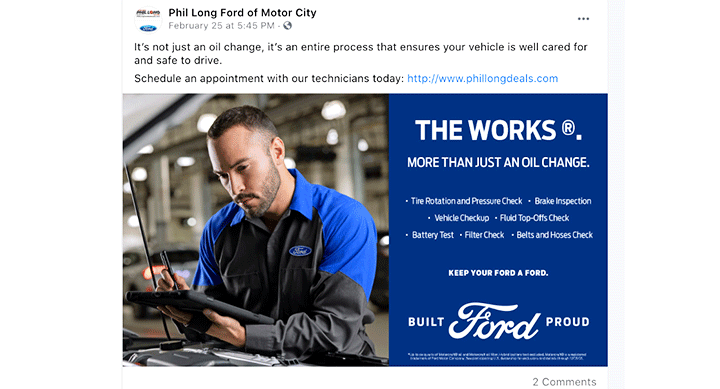
Simply take a scroll through Facebook on a Saturday afternoon. You’ll probably see people posting stories of vehicle issues and asking for recommendations.
Across Facebook, Twitter, and Instagram, social media can do more than just raise brand awareness for your fixed ops. It can show how you’re genuinely helping your customers. You may not become an overnight influencer, but here are a few best practices to optimize your engagement:
- - Retweeting and favoriting things your followers’ post
- Commenting on followers’ posts
- Being responsive to comments on your posts
- Responding to mentions
- Connecting with other professionals in your field or local area
- Uploading shareable videos, photos, and content
- Following/adding customers on social media
- Beyond just boosting your organic social media presence with the tips above, many dealerships choose to run paid social campaigns as well. With targeted ads (on Facebook, Twitter, and even Instagram) promoting your fixed ops and relevant specials, you can reach audiences that traditional media often overlooks.
4. Encourage customer reviews
Online reviews are great for helping potential customers decide on where to go for service. But they’re also essential for helping customers find you in the first place. When people in your community write about you online, it affects your SEO and increases your visibility (see #1).
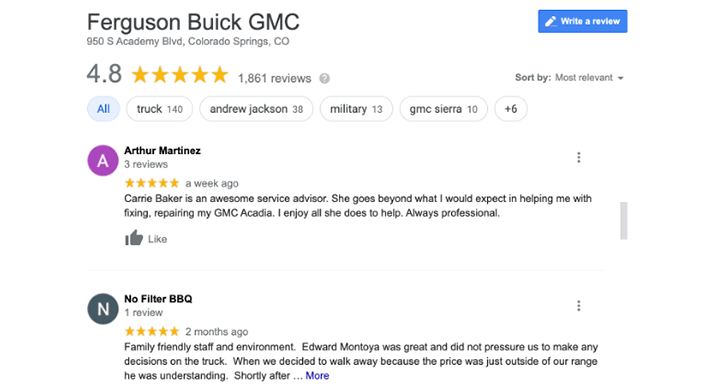
Like it or not, customers today are probably reading about you online before they pick up the phone or go online to make an appointment. So the more positive reviews you can bank, the better it is for your brand image. Here are some tips to help your service department get more positive reviews.
5. Launch a value-added incentive program
Incentive programs can be a marketing machine for dealer service departments. By partnering with the right provider, you can offer your current and future customers a unique suite of benefits with each oil change that both helps with retention and encourages future business.
Mazda of Orland Park is a great example of what incentives can do to supercharge fixed ops marketing. With an enticing program in place, they were able to increase their market share and improve customer retention resulting in 6X ROI.
Is Your Marketing Cutting Through the Clutter?
It can be difficult for fixed ops directors to ensure their service departments stand out in a crowded industry. But with the right strategy, you can make sure you’re front and center when customers are considering vehicle maintenance and repair.
Aside from unrivaled benefits that make you the go-to provider for maintenance, tires, and unplanned repairs, DriveSure’s experience with all things fixed ops marketing (including more tried and true tactics like SMS, email, and direct mail) can help you outshine the competition.
To find out how, contact us today for a free 30-minute consultation.
Bill Springer has been helping dealerships grow their business at Krex, Inc. since 1987. As President of the organization, he is dedicated to helping service and sales departments provide unbeatable value to their customers. Krex’s signature solution, DriveSure, is specifically designed to make dealerships the only provider car owners depend on for maintenance, tires, and repairs.
DriveSure
Tips and Strategies to Get More Positive Customer Reviews
Like it or not, customer reviews are a big deal for dealership service departments. We know, it doesn’t always feel fair that a seemingly innocuous set of “star ratings” can have such an impact. But it does.
But it does.
Many potential new customers are going online to vet you long before they make an appointment to bring their vehicle in for service. And what they read in that list of reviews will shape what they think about you before they drive into your service bay.
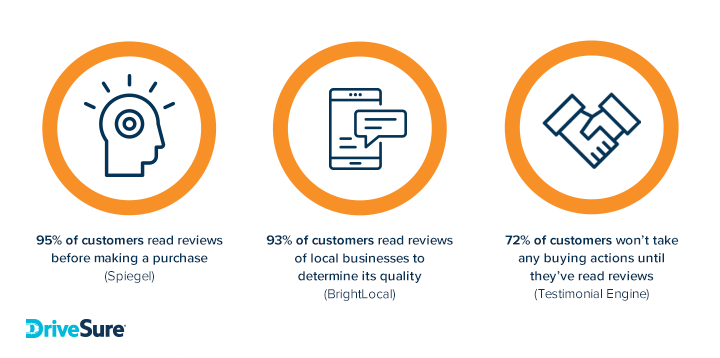
While those numbers may not be specific to auto dealership service departments, you can be sure they apply to our industry, too. Whether retaining current customers, getting new buyers to return for their first service appointment, or attracting new business — having a bank of (hopefully positive) online reviews is not only good for potential customers when they’re deciding on service and maintenance, it also helps them find you in the first place. When people in your community write about you online, it affects your SEO (search engine optimization) and increases your visibility.
Think of online reviews as a “navigational beacon” that can help point a potential customer in your direction!
Creating an Effective Customer Review Process
Getting customers to write reviews really is a virtuous cycle that can benefit your service department in many ways. But it’s not as easy as simply telling your team to ask customers to submit reviews. No amount of “review us” stickers in your lobby will singlehandedly have an impact on the number of reviews you generate.
Boosting the number and level of reviews comes from a well-defined process and some key habit-forming behaviors.
1. Provide Great Service
Great customer service is the catalyst for an exceptional customer experience. And a positive experience compels positive reviews.
Especially for dealer service departments who compete with local mechanics that often offer a lower price point for service. Providing superior quality of work and customer service will make it easier for you to elicit glowing reviews — and retain customers.
Every interaction counts. From the ease of using your website, to the way they’re greeted when they call, to their waiting room experience, post-appointment follow-ups, and so on.
Customers have even been known to review the cleanliness of the bathroom, type of on-site amenities, and the amount of paperwork they have to fill out. Some of that is out of your control, but spend time making sure that every touch point that is in your control is as personal as possible.
Ensure ease and convenience throughout the entire process, and your customer reviews will be a sight to behold — in both volume and rating!
2. Make it a Team Sport
One of the best ways to encourage and incentivize customer reviews is getting your entire team on board.
By simply telling the staff “Hey, we got four 5-star reviews last week, let’s see how many we can get next week.” Then, when you’re up six more reviews the following week, everyone high fives and feels great.
This is where a goal board or some visual back area of your office can serve as a reminder of the goal, and rally everyone’s efforts around boosting review numbers.
To accomplish this, it’s often as simple as making sure your techs and office staff stress how valuable customer feedback is during the check-out process and provide instruction on where to go online to leave a quick review.
3. Use Technology
We’ve talked before about why your dealership needs to truly embrace the digital age.
Tapping into digital marketing can be especially helpful in streamlining your customer reviews. Many dealership service departments use tools like Podium and RepLev to automate the process:
- - When the RO is closed, the system sends a text to the customer inviting them to share their feedback with a link
- - The link takes the customer to a page that asks then to leave a review on Google, Facebook, DealerRater, Edmunds, etc. (this can be customized
- - Automated email campaigns soliciting reviews can also be created as part of your customer follow-up
- - Many systems will even track and alert you to negative reviews so you can personally respond
All easy, non-invasive, one-click opportunities to gain reviews. And as your customers are becoming more open to being communicated to digitally, they’re happy to oblige and leave a quick review.

How to Leverage Positive Reviews
Having a sizable collection of customer reviews out in the Internet ether to help spread the word is great. But if you can creatively use some of those reviews to further promote your service department — that’s even better. Brad Deery Motors in Iowa does a great job leveraging their positive reviews for maximum traction and exposure.
Used in email campaigns, Facebook and Google Ads, and even on YouTube if you can get video testimonials, the “customer review ads” always receive a good response rate.
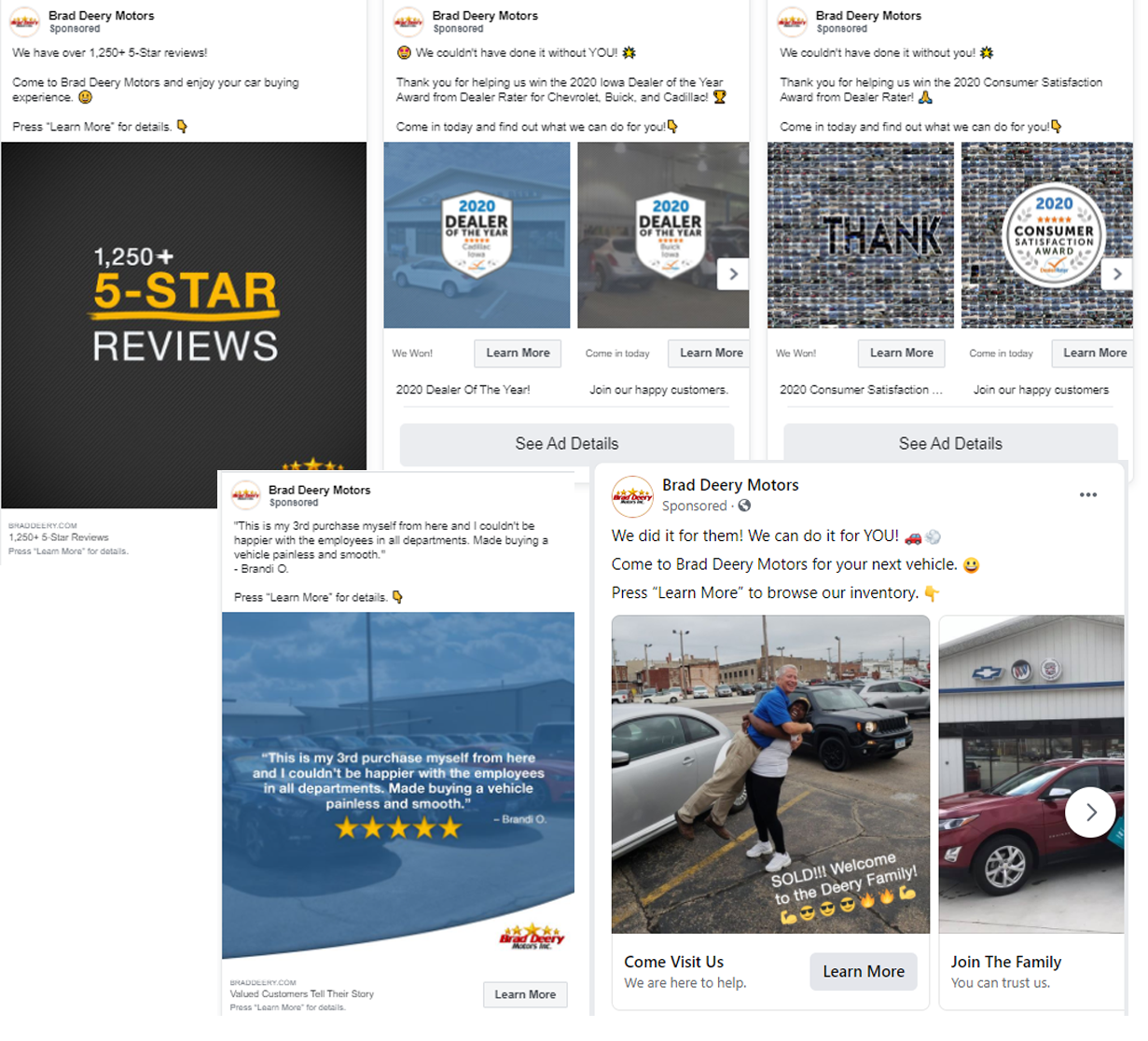
How to Handle Negative Reviews
Try as we might, we can’t please everyone. Negative reviews are inevitable, whether warranted or not.
So just be sure to regularly check your customer reviews on Google, Yelp, Edmunds, and DealerRater. It’s imperative you stay in the know on what they liked about their experience, what they didn’t like, and if they had expectations you couldn’t meet.
Acknowledge all reviews and personally respond to the negative ones with an effort to remedy the issue — get on the phone if you have to. Before you reach out, talk to any of your managers or employees who may have been mentioned in the reviews (good or bad) and understand their perspective.
Do You Have a Service Department Customers Can Rely On?
There’s no doubt customer reviews can help drive your business forward, and we hope some of the tips shared here will help increase your positive online reviews. Remember that ultimately, dealerships that offer unbeatable vehicle maintenance and customer service are far more likely to dominate the review’s arena, which in turn sparks interest in potential customers and future business.
If you’re interested in learning more about how DriveSure’s unique suite of benefits helps dealerships stand out from the crowd, contact us today for a free 30-minute consultation.
Bill Springer has been helping dealerships grow their business at Krex, Inc. since 1987. As President of the organization, he is dedicated to helping service and sales departments provide unbeatable value to their customers. Krex’s signature solution, DriveSure, is specifically designed to make dealerships the only provider car owners depend on for maintenance, tires, and repairs.
No Comments
DriveSure
Texting Is Now the Top Preference for Service Customers
 Texting has come a long way since the days of flip phones and message limits. What was once a communication channel reserved only for our closest friends and family is now a common way we interact with businesses.
Texting has come a long way since the days of flip phones and message limits. What was once a communication channel reserved only for our closest friends and family is now a common way we interact with businesses.
This evolution isn’t exactly new, but we were still a bit surprised by some of the stats that came out of our 2020 Dealership Service Retention Report. For the nearly 2,000 dealership service customers we surveyed, texting wasn’t just a popular communication method. It was consumers' favorite way to receive communications from a dealership – by a long shot.
Texting Preferred Over Calls by Nearly 3 to 1 During Service
When we asked our research participants to identify their most preferred way to hear from a dealership during a service visit, 60% of them identified text messages. A phone call was the second most common choice, but it was picked by only 22% of respondents, trailing texting by a significant margin. In fact, phone calls beat out email by just 7%.
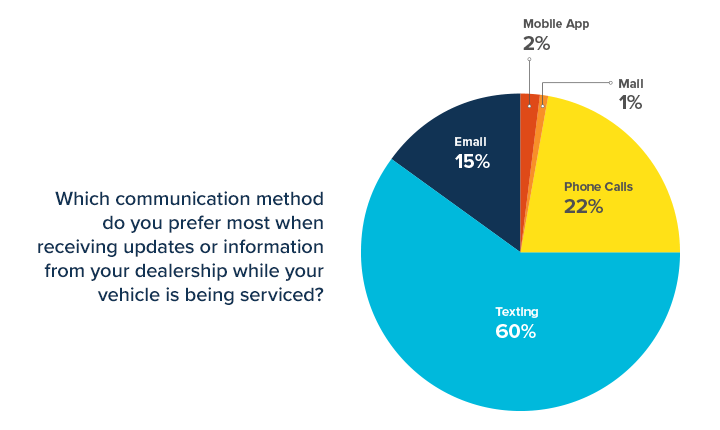
So if your dealership is still questioning whether customers are open to getting texts from you, wonder no more. Not only are they open to it, but the majority of them actually prefer it.
What about more senior customers? Yes, them too. Texting was the preferred communication method for every age group we surveyed. While the margin between texting and calls wasn’t as wide for customers 55 and above, they were still twice as likely to prefer a text over a call.
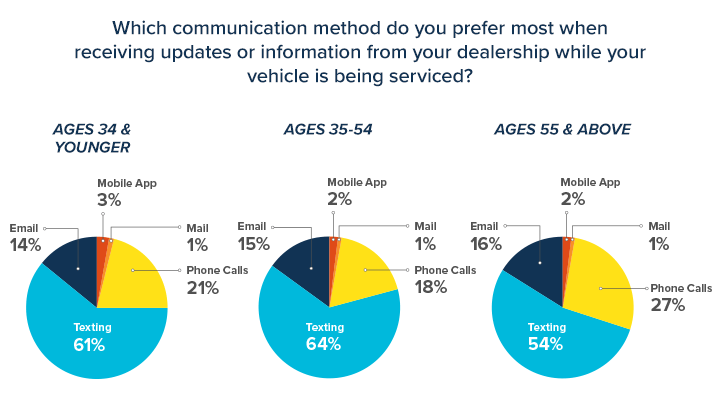
In addition to figuring out how customers wanted to be contacted while their vehicle was getting serviced, we also wanted to know what they preferred for the less immediate communications between visits. It turns out texting is pretty popular for that as well.
Texting Is Second Most Popular Preference Between Service Visits
Email has long been the king of non-urgent customer communications, and our research shows that texting hasn’t dethroned it yet. 50% of the service customers we surveyed prefer to receive emails over other communication methods between service visits.
However, texting does have a strong hold on second place. Nearly a third of the people we surveyed prefer texts (32%), followed by phone calls (12%), mail (4%), and a mobile app (2%).
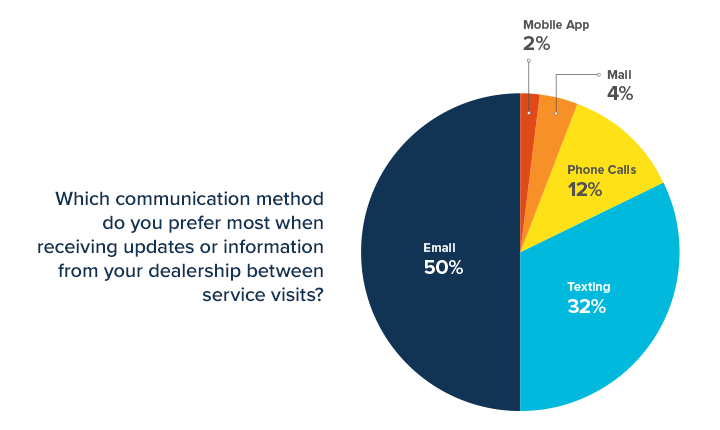
Again, the preferences stayed in the same order across age groups. About the same percentage of customers ages 34 and younger preferred texting as those 35-54 (37% and 36% respectively). For people 55 and above, they were slightly less likely to prefer texting (23%), with email making up the majority of the difference.
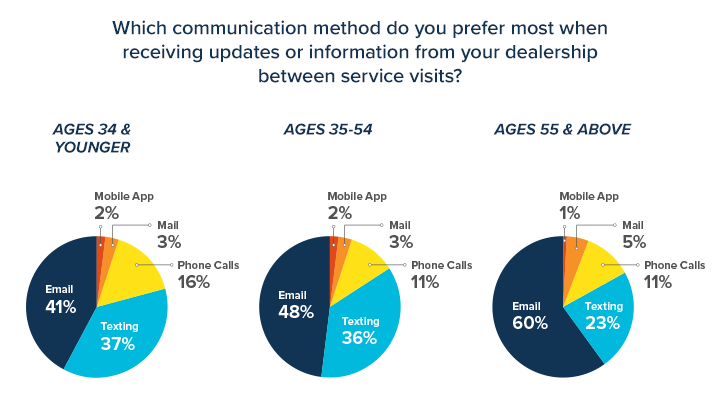
We see two big takeaways for dealerships here:
First, maintain your email strategy. It seems that questions come up every year about whether email is dead or dying – this data clearly shows that it’s still an effective tool.
Second, texting shouldn’t just be used for real-time communication while you’re servicing a customer’s vehicle. It can also be a great way to reach customers between service visits for things such as service reminders.
There’s one caveat to this data we want to mention. The question we asked was for participants to choose their most preferred communication method, and they were only able to pick one. So, while mail didn’t perform well as a top choice, we know from our work with dealerships that direct mail is still a valuable tool for driving business.
Dealerships May Not Be Keeping Up
So how are dealerships’ communication channels lining up with their customers’ preferences? It turns out that there is some alignment, but many dealerships still have some work to do.
Almost 90% of people surveyed get emails from their dealership. This shows that dealerships have a good handle on the most preferred format for messages between service visits.
However, more than 40% of people surveyed don’t get any texts from their dealerships. If the data about communication preferences is clear about one thing, it’s that the dealerships that haven’t adopted a solid strategy for sending text messages to customers should start now.
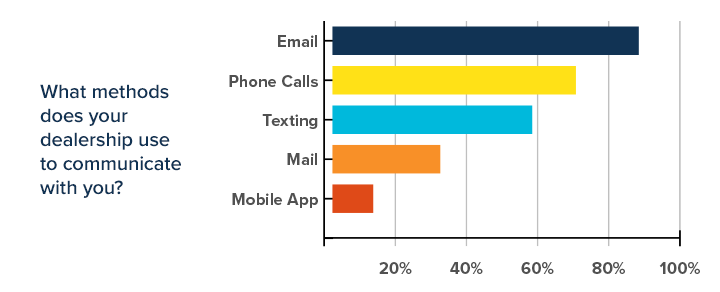
But when it comes to modernizing communications with customers, dealerships may not want to stop there.
What’s Next for Dealership Communication?
At DriveSure, we’re laser-focused on helping dealerships bring more customers back to their service department more often. In addition to our suite of renewable, value-added benefits like roadside assistance and tire coverage, we help dealerships send the most effective service-reminder messages possible.
Over the last year or so, we’ve introduced a new form of service reminders called our Digital Pass. Among other functions, it allows customers to get app-like notifications on their smartphone when it’s time to return to the dealership’s service department.
Since this is a brand new form of communication in the industry, we wanted to gauge dealership service customers’ reactions to it in this survey. To be honest, even we were surprised by what we found.
Over half of the participants told us they would be likely or very likely to download a digital reminder notice on their smartphone to receive service reminders. Based on this response, we’re confident that smartphone notifications through tools like the DriveSure Digital Pass will be the next evolution in modern communication with your customers.
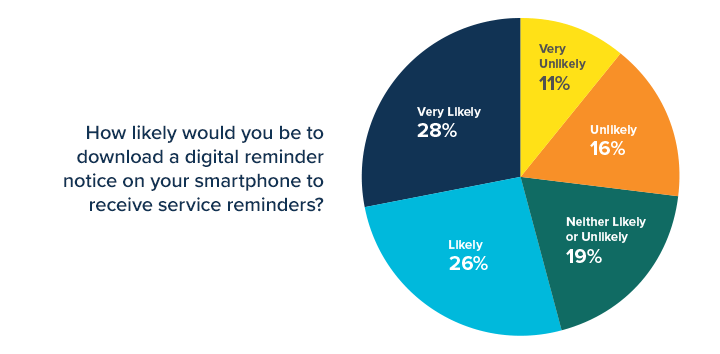
What Dealerships Should Do
Dealerships that aren’t yet texting customers during and between service visits, should begin looking into the technology that makes this easy. For those that already text customers, begin thinking about what’s next on the horizon for effective customer communications. If you need help implementing texting or smartphone notifications, or you just want to boost retention and service visit frequency, we’d be happy to chat.
Otherwise, be sure to grab a free copy of our 2020 Dealership Service Retention Report for more insights from nearly 2,000 dealership service customers about why they return for service, why they don’t, and what your dealership can do about it.
Bill Springer has been helping dealerships grow their business at Krex, Inc. since 1987. As President of the organization, he is dedicated to helping service and sales departments provide unbeatable value to their customers. Krex’s signature solution, DriveSure, is specifically designed to make dealerships the only provider car owners depend on for maintenance, tires, and repairs
3 Comments
DriveSure
Hi Morgan, great question! Our survey respondents were service customers at a wide variety of dealerships across the country. Different states, makes, and dealership sizes were represented in the results.
No Comments